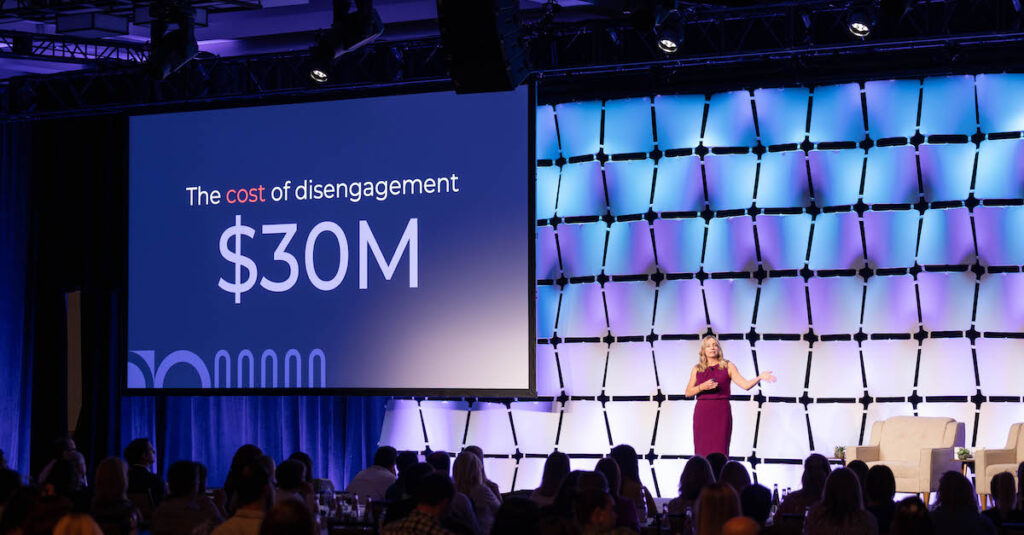This past September, we wrapped up Attune ’23 in Phoenix. This premier employee experience event gives business leaders an opportunity to come together and share ideas on empowering workforces and upleveling the employee experience.
Every year, Attune attendees return to their companies with innovative strategies to better understand the employee journey. The insights they gain at the event allow them to meaningfully improve upon the employee experience—unlocking higher engagement and higher profitability along the way.
Attune ’23 offered a wealth of knowledge on the pivotal impact of communication in driving business growth and improving the bottom line.
Here are three key takeaways from the event that will resonate with every CEO.
1. Employee experience is a C-level opportunity
There’s no doubt that business leaders recognize how critical an exceptional customer experience is. But what about the employee experience?
According to Gallup, a disengaged employee can cost their company up to 34% of their salary. On the flip side, companies with highly engaged employees tend to be 23% more profitable and 18% more productive than their less engaged counterparts.
These numbers speak for themselves. If you’re a leader with your sights set on retention and revenue growth, it’s time to refocus on the employee experience. Treat employees as internal customers and utilize the talents of HR, IT, and communications to improve the employee experience for every worker.
“This is about creating the moments that resonate with each person. And this is a C-level problem and opportunity. How do we truly connect with people to make them understand their role and purpose at work?”
— Nicole Alvino, founder and CEO, Firstup
All of this underlines the importance of personalized, contextualized communications—at scale. By connecting with people at precisely the right moment, businesses can realize their engagement, productivity, and revenue goals.
2. Real-time data is essential for ROI
One of the most valuable resources business leaders have to realize a better return on investment on their engagement programs rests in the massive volumes of data their organizations create on a daily basis.
But this isn’t about collecting data for data’s sake. It’s about diving deeper to find the true story hidden underneath so you can engage with employees in a more effective way.
At Attune, Chris Butler, CEO of One Model, and Richard Rosenow, the company’s VP of People Analytics & Strategy, discussed at length how businesses can leverage insights to help predict and solve issues that could negatively impact employee engagement and retention.
In partnership with Firstup, they quickly found that the right data can help organizations take the guesswork out of employee attrition and take proactive action.
“Data is the starting point. Think about every employee interaction with internal communications, every time they comment or share—and when they do not. These are important signals to help you understand your people and what truly matters to them.”
— Nicole Alvino, Founder and CEO, Firstup
One of the strongest leading indicators of unhappy workers is communication engagement data. Leaders can reduce attrition if early action is taken to understand and address the causes for employee discontent. If you’re curious whether top tier talent is ready to leave the organization, monitoring these trends will identify problems in need of quick solutions.
The same concept is true of continuity in the workforce. Employees with high engagement within a communications platform, also known as “power users,” tend to also be high performers in their role.
Data can point to those with real influence in the organization. When these top performers leave, they leave a costly hole in their departments. Understanding who they are today is essential for mitigating risk tomorrow.
“Most of the data that we look at is after the fact. By the time you process attrition from the last quarter or last year, months have passed. What we’re looking for is predictive data that helps you change a business outcome moving forward.”
— Evan Wittenberg, Chief People Officer, Pivot Bio
3. AI is inevitable—what matters is how you use it
Instead of dreading artificial intelligence (AI), businesses can capitalize on the opportunity it represents.
AI won’t replace humans, but it can augment their capabilities. A recent study by Harvard Business School and Boston Consulting Group revealed that AI helped make people 12% more productive and capable of completing work 25% faster. There was also a 40% increase in the quality of their work.
“AI is an agent to work with you or work against you if you don’t get a handle on it now, which is why we have the opportunity to experiment.”
— Juliette Powell, AI expert and author of The AI Dilemma
AI can make C-suite, HR, and internal communications more strategic, data-driven, and personalized for every worker.
These tools can also help make HR and comms teams more efficient by automating repetitive, time-consuming tasks. Firstup recently announced enhanced AI features in our intelligent communication platform to help create quality content, segment audiences, boost engagement, and capture data that can help predict attrition.
With the saved time, business leaders can spend more time on what matters most—building relationships with employees, developing talent, and creating a positive work culture.
Build a people-centric business
At Firstup, our goal is simple: we want to help leaders better understand their workforce, make informed decisions, and build people-first workplaces. We do this by empowering businesses to meaningfully engage with employees at every moment and delivering insights to promote and retain your people.
For more insights on pressing issues facing business leaders, check out the on-demand library of Attune ’23 content.
Download PDF








